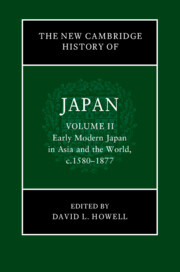Book contents
- The New Cambridge History of Japan
- The New Cambridge History of Japan
- The New Cambridge History of Japan
- Copyright page
- Contents
- Figures
- Maps
- Tables
- Contributors to Volume II
- Preface
- Frontispiece
- Introduction
- Part I The Character of the Early Modern State
- PART II Economy, Environment, and Technology
- Part III Social Practices and Cultures of Early Modern Japan
- 13 Religion in the Tokugawa Period
- 14 The Medical Revolution in Early Modern Japan
- 15 Flows of People and Things in Early Modern Japan
- 16 Labor and Migration in Tokugawa Japan
- 17 The Tokugawa Status Order
- 18 On the Peripheries of the Japanese Archipelago
- 19 The Early Modern City in Japan
- 20 Popular Movements in Early Modern Japan
- 21 Civilization and Enlightenment in Early Meiji Japan
- Index
- References
14 - The Medical Revolution in Early Modern Japan
from Part III - Social Practices and Cultures of Early Modern Japan
Published online by Cambridge University Press: 15 January 2024
- The New Cambridge History of Japan
- The New Cambridge History of Japan
- The New Cambridge History of Japan
- Copyright page
- Contents
- Figures
- Maps
- Tables
- Contributors to Volume II
- Preface
- Frontispiece
- Introduction
- Part I The Character of the Early Modern State
- PART II Economy, Environment, and Technology
- Part III Social Practices and Cultures of Early Modern Japan
- 13 Religion in the Tokugawa Period
- 14 The Medical Revolution in Early Modern Japan
- 15 Flows of People and Things in Early Modern Japan
- 16 Labor and Migration in Tokugawa Japan
- 17 The Tokugawa Status Order
- 18 On the Peripheries of the Japanese Archipelago
- 19 The Early Modern City in Japan
- 20 Popular Movements in Early Modern Japan
- 21 Civilization and Enlightenment in Early Meiji Japan
- Index
- References
Summary
This chapter explores the “medical revolution” of Tokugawa Japan. At the beginning of this period, medical care by physicians was largely an urban phenomenon, but over the course of some 200 years, medicine became an integral part of everyday life in towns and villages all around Japan. The political authorities had little involvement in the expansion of the medical profession, which instead was driven by commercial and social factors. The development of print culture made medical knowledge more widely available, both to physicians and the larger public, while the tensions of the status system made the medical profession desirable to many, from low-ranking members of the warrior status group to the ambitious sons of villager families. Medical academies established by prominent doctors in cities such as Kyoto, Edo, Osaka, and Nagasaki made it possible for would-be doctors to acquire training in a variety of new medical fields, from obstetrics to so-called Dutch medicine. However, by the early nineteenth century, the proliferation of doctors with varying degrees of training and skill and the increasingly intense competition among them led some localities to adopt new licensing measures designed to weed out “quacks” and ensure the livelihood of established doctors.
Keywords
- Type
- Chapter
- Information
- The New Cambridge History of Japan , pp. 478 - 506Publisher: Cambridge University PressPrint publication year: 2023

